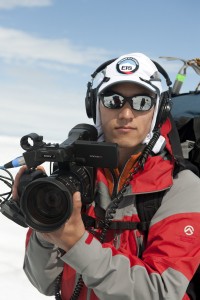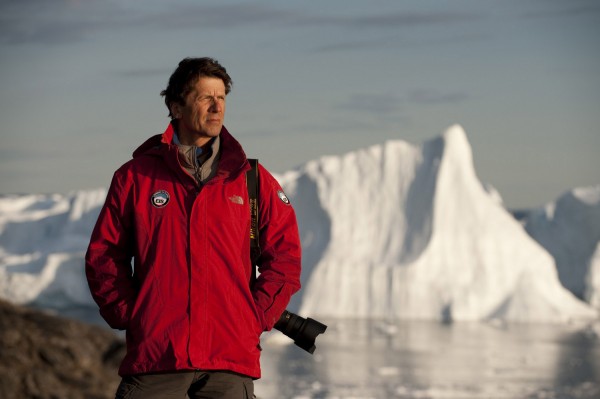23 January 2012
AGU Video: As their film debuts at Sundance, scientists call for simple, personal tales
Posted by mcadams
[youtube=http://www.youtube.com/watch?v=DBQtEQIDNcA&feature=youtu.be]
Photographer and AGU member James Balog urges scientists to “show us the cool stuff” when communicating with non-scientists. Balog, the subject of the documentary film “Chasing Ice,” premiering Jan. 23 at the 2012 Sundance Film Festival, stopped by AGU headquarters in Washington, D.C., in early January to talk about the challenges and rewards of being a scientist-communicator.
Seven years ago, photographer James Balog was struggling to fulfill an assignment for The New Yorker magazine: How to bring the story of climate change to the world. His journey from that first glacier shoot to a five-year project recording glacier change and loss is the subject of “Chasing Ice,” a documentary premiering today at the Sundance Film Festival in Park City, Utah.
Convinced there was a story in the ice but unsure of how to capture it for The New Yorker, Balog headed out to photograph a glacier in Iceland, trusting that if he committed himself to telling the story, the creative muses would make it happen–and they did. That story led to another, more involved assignment: National Geographic’s June 2007 cover story on glaciers, “The Big Thaw.”
Moved by what he witnessed in those assignments, Balog founded the Extreme Ice Survey (EIS), a project which uses time-lapse photography in Greenland, Alaska, the Himalayas and elsewhere to bring to audiences of every latitude the story of how glaciers around the world continue to change.
“Visual imagery is so powerful,” said EIS team-member and U.S. Geological Survey research ecologist Daniel Fagre. “People don’t even have to have any data to understand what’s going on.” Fagre helps train park interpreters at Glacier National Park in Montana. He and his park crew carry cameras to photo-document much of what they do, making their data visual instead of just numbers.
Not every scientist with a story to tell can offer obvious eye candy like EIS does, but any scientist can communicate better in any media by following one rule, said several EIS team members: Keep it simple.
“Just get to the point. It’s not to your benefit to overwhelm the audience with information,” said Jason Box of EIS and the Byrd Polar Research Center, and a geography professor at The Ohio State University in Columbus. “You have a limited time with your audience and a limited amount of information you can convey.”
Try to “think about [your story] from the point of view of the person who is very unfamiliar with what is going on” — and make it succinct, said Tad Pfeffer, a professor in the Department of Civil and Environmental Architectural Engineering at the University of Colorado in Boulder. Being compact and direct is not something scientists may be accustomed to, but practice makes perfect, he noted.
Pfeffer, who screened “Chasing Ice” for scientific accuracy, acknowledged that walking the line between simplicity and scientific accuracy is difficult. Journalists, such as documentary filmmakers, and scientists “come at this whole business of communicating from very different perspectives,” he said. Journalists want to find a compelling story while scientists are busy thinking, “Is what we said correct? Are we saying enough? Are we open to misinterpretation or misunderstandings?”
Balog urged scientists to go a step further and make their story personal.

"Chasing Ice" director Jeff Orlowski at the Greenland Ice Sheet in June 2009. © 2010 James Balog/Extreme Ice Survey
“In the science community, guys don’t like to…talk about the dramas they had in the field – the storms, the helicopter crashes or problems, the equipment breakdowns, the headaches about trying to understand what was going on,” Balog said. “But lay people like to hear that stuff. They want to hear what’s under the hood of all this. It brings it alive. It makes it human. It makes it personal.”
Balancing the “Chasing Ice” story and its science was “one of the hardest things about making this film,” said director Jeff Orlowski, reflecting on the 5-year odyssey. Although the film is about climate change, it plays a lot like a narrative featuring Balog as the protagonist and science as a supporting character, he said.
Even before its premiere, “Chasing Ice” has made a stir at Sundance. Its five screenings sold out over two weeks ago and the film, along with five others, was selected from more than 90 films to be pre-screened by the festival’s volunteer staff.
To Balog, Sundance represents “a huge new forum for telling the story of climate change as seen through the glaciers.” It “gives us an amplification and a leverage into new audiences that we didn’t have before. I’m thrilled about it.”
By Mary Catherine Adams, AGU Public Information Specialist











 The Plainspoken Scientist is the science communication blog of AGU’s Sharing Science program. With this blog, we wish to showcase creative and effective science communication via multiple mediums and modes.
The Plainspoken Scientist is the science communication blog of AGU’s Sharing Science program. With this blog, we wish to showcase creative and effective science communication via multiple mediums and modes.
At a recent party I was trapped by a trial lawyer into talking about global climate change. Within minutes everyone in the room but he and I had left. It eventually became clear that he had no interest in facts or explanations. Instead his questions were designed to bring doubt to the minds of a “jury. “How do you know…”; “What is the accuracy of …”, “Have such changes ever occurred in the past history of the Earth? “Are there alternative explanations?” I was soon enmeshed in long, tortuous explanations that required knowledge I did not have and he and the jury could not have understood if I did. Most scientists are unprepared for such conversations and unlikely to leave a favorable impression on the audience. I am uncertain what techniques would work in this situation.
Robert, thank you for your comment. To answer your question, there are a handful of resources AGU provides for members who want tips on how to handle these kinds of situations and also how to speak about their science to a general audience in any scenario, the least of which is this blog. One event that might be of particular interest to you is the “AGU Chapman Conference on Communicating Climate Science: A Historic Look to the Future” being held in Santorini, Greece this August: http://www.agu.org/meetings/chapman/2012/ccall/. AGU also offers communications training at the annual Fall Meeting (a look at last year’s training: http://sites.agu.org/fallmeeting/communicating-your-science-panel-and-workshops/) and are expanding to other meetings, like the AGU Science Policy Conference being held this Spring in Washington, D.C.: http://sites.agu.org/spconference/events/. Additionally, there were several sessions at the 2011 Fall Meeting dedicated specifically to communicating climate change. If you are planning on attending the 2012 Fall Meeting, please consider that there may be more of those types of sessions at this year’s meeting. If there is anything more that we can do for you, please feel free to contact us in the public information office: http://www.agu.org/news/. We would be happy to talk to you! Sincerely, Mary Catherine Adams, AGU Public Information Specialist
Probably the best rejoinders in this situation involve going meta:
1. “Right now, are you speaking as a lawyer, or as a scientist?”
2. “Is there any chance that you could be wrong?”
3. “Are you aware of where you can find the counterargument to what you’ve just said?” ( SkepticalScience.com )
4. “Wouldn’t it be smarter to choose the path of the least detrimental outcome?” (This is the Greg Craven approach, that someone recommended taking recently)